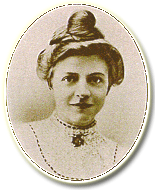History (con't)

Clara was appointed to work with yellow fever patients at Las Animas. Her career had always been one of helping others. The inoculation experiment gave her a chance to help advance medical science. Being immune would also help in her work with those who suffered from the disease.
Clara was one of 19 participants—and the only woman, as well as the only American—exposed on several occasions to mosquitoes that were believe to be infected. She received bites seven times during March, May, June and August of 1901.
Until August, among all the participants, only one contracted a mild case of the disease. In August, however, there were seven cases of yellow fever. When Clara was bitten for the last time, on August 14, it was determined that the same mosquitoes had already caused two cases of yellow fever. She became ill on August 18 and died on August 24, 1901.
The major New York City newspapers carried the story of her death, noting that the $100 fee she received for participating in the experiment was forwarded to her mother to help out with finances at home.
The experiment demonstrated that the bite of infected mosquitoes could not be used as a safe way to provide immunity. This was an important finding for medical science's understanding of the disease. The vaccine employed against yellow fever today uses a weakened strain of the virus. Victory over the disease in Cuba and Panama would come from control of the mosquito populations. The experiment also confirmed conclusively the earlier findings regarding transmission by mosquitoes.
Clara was buried quickly in Havana. A year later, her lead casket was disinterred and returned to the United States. She was reburied in Fairmont Cemetery in Newark. There was originally a small Army stone on the grave, but it was replaced in May 1930 after a fundraising campaign led by Leopoldine Guinther, superintendent of Newark Memorial Hospital (formerly Newark German Hospital). Guinther, more than any other person, was responsible for keeping alive the memory of Clara Maass.
In 1918, Newark German Hospital was renamed Newark Memorial Hospital. It later became Lutheran Memorial Hospital. In 1952 the name was changed to Clara Maass Memorial Hospital, and is today known as Clara Maass Medical Center.
Pastor Arthur Herbert was a dedicated campaigner to win greater recognition for Clara Maass. He was especially interested in seeing her honored on a US postage stamp. The Cuban government was the first to honor Clara Maass with a stamp, issued in 1951 to commemorate the 50th anniversary of her death. A school and a hospital unit in Cuba had also been named for her.
In 1976, honoring the centennial of Clara Maass' birth, a US postage stamp was issued. Numerous articles and two books have been written about Clara Maass, since she is recognized as a heroic figure in the history of American medicine and humanity. Perhaps the strongest memorial to Clara Maass is the Medical Center that carries on her spirit of caring and adventure, administering quality health care in her name.
Clara Maass Medical Center also maintains a small museum on campus as a living monument to Nurse Maass. The exhibit includes personal items, as well as letters and documents.



